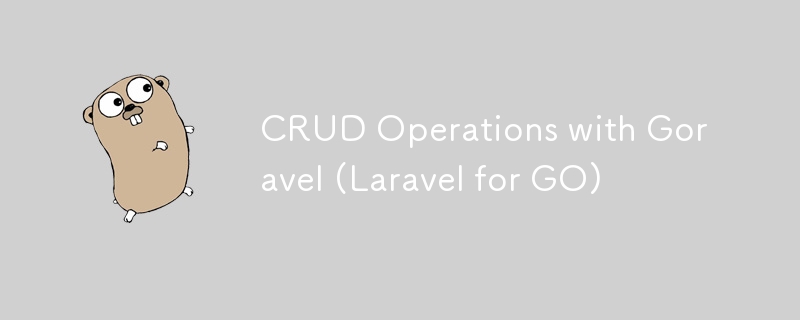使用 Goravel 进行 CRUD 操作 (Laravel for GO)

关于Goravel
Goravel是一个功能齐全、扩展性极佳的Web应用框架,作为入门脚手架,帮助Gopher快速构建自己的应用。
Goravel 是针对 Go 开发人员的 Laravel 的完美克隆,这意味着像我这样的 PHP 开发人员可以轻松地与该框架建立联系并开始编写,几乎不需要学习。
下面开始安装,您可以按照本文安装或访问Goravel官方文档网站。
// Download framework git clone https://github.com/goravel/goravel.git && rm -rf goravel/.git* // Install dependencies cd goravel && go mod tidy // Create .env environment configuration file cp .env.example .env // Generate application key go run . artisan key:generate //start the application go run .
在你最喜欢的文本编辑器中打开代码,你会看到项目结构与 Laravel 完全一样,所以 Laravel 开发者不会感到如此迷失。
模型、迁移和控制器
要创建模型、迁移和控制器,我们可以使用 artisan 命令,就像在 Laravel 中一样。
// create model go run . artisan make:model Category // create migration go run . artisan make:migration create_categories_table // create controller go run . artisan make:controller --resource category_controller
现在,如果我们检查数据库/迁移文件夹,我们将看到已经为我们创建了文件,向上和向下文件,打开向上迁移文件并将以下代码粘贴到其中:
CREATE TABLE categories ( id bigint(20) unsigned NOT NULL AUTO_INCREMENT, name varchar(255) NOT NULL, created_at datetime(3) NOT NULL, updated_at datetime(3) NOT NULL, PRIMARY KEY (id), KEY idx_categories_created_at (created_at), KEY idx_categories_updated_at (updated_at) ) ENGINE = InnoDB DEFAULT CHARSET = utf8mb4;NGINE = InnoDB DEFAULT CHARSET = utf8mb4;
如果我们检查app/http/controllers文件夹中,我们将有一个category_controller.go文件,里面的内容应该如下所示:
package controllers
import (
"github.com/goravel/framework/contracts/http"
)
type CategoryController struct {
//Dependent services
}
func NewCategoryController() *CategoryController {
return &CategoryController{
//Inject services
}
}
func (r *CategoryController) Index(ctx http.Context) http.Response {
return nil
}
func (r *CategoryController) Show(ctx http.Context) http.Response {
return nil
}
func (r *CategoryController) Store(ctx http.Context) http.Response {
return nil
}
func (r *CategoryController) Update(ctx http.Context) http.Response {
return nil
}
func (r *CategoryController) Destroy(ctx http.Context) http.Response {
return nil
}
然后,让我们在 app/http/model 中找到类别模型文件,然后将以下代码粘贴到其中:
package models
import (
"github.com/goravel/framework/database/orm"
)
type Category struct {
orm.Model
Name string
}
这里没有发生什么,我们只是用他们的数据类型声明我们的可填充。
让我们在路由文件夹中找到 api.php 文件并将代码更新为如下所示:
package routes
import (
"github.com/goravel/framework/facades"
"goravel/app/http/controllers"
)
func Api() {
userController := controllers.NewUserController()
facades.Route().Get("/users/{id}", userController.Show)
//Resource route
categoryController := controllers.NewCategoryController()
facades.Route().Resource("/category", categoryController)
}
现在,让我们更新category_controller.go 文件中的导入并将其更新为以下内容:
import ( "goravel/app/models" "github.com/goravel/framework/contracts/http" "github.com/goravel/framework/facades" )
我们刚刚导入了模型和门面,门面让我们能够访问很多很酷有用的东西,比如验证、orm 等。orm 是 GO 的 ORM。
是时候编写一些代码了!
让我们将控制器中的方法更新为以下代码:
索引方法
// this is just to pull all categories in our database
func (r *CategoryController) Index(ctx http.Context) http.Response {
var categories []models.Category
if err := facades.Orm().Query().Find(&categories); err != nil {
return ctx.Response().Json(http.StatusInternalServerError, http.Json{
"error": err.Error(),
})
}
return ctx.Response().Success().Json(http.Json{
"success": true,
"message": "Data fetch successfully",
"data": categories,
})
}
储存方法
func (r *CategoryController) Store(ctx http.Context) http.Response {
// validate the input name that the user is passing
validation, err := facades.Validation().Make(ctx.Request().All(), map[string]string{
"name": "required|string",
})
// check if an error occured, might not be validation error
if err != nil {
return ctx.Response().Json(http.StatusInternalServerError, http.Json{
"success": false,
"message": "Validation setup failed",
"error": err.Error(),
})
}
// check for validation errors
if validation.Fails() {
return ctx.Response().Json(http.StatusBadRequest, http.Json{
"success": false,
"message": "Validation failed",
"errors": validation.Errors().All(),
})
}
// Create the category
category := &models.Category{
Name: ctx.Request().Input("name"),
}
// save the category and return error if there is any
if err := facades.Orm().Query().Create(category); err != nil {
return ctx.Response().Json(http.StatusInternalServerError, http.Json{
"success": false,
"errors": err.Error(),
})
}
// upon successfull creation return success response with the newly created category
return ctx.Response().Success().Json(http.Json{
"success": true,
"message": "Category created successfully",
"data": category,
})
}
更新方法
func (r *CategoryController) Update(ctx http.Context) http.Response {
validation, err := facades.Validation().Make(ctx.Request().All(), map[string]string{
"id": "required",
"name": "required|string",
})
if err != nil {
return ctx.Response().Json(http.StatusInternalServerError, http.Json{
"success": false,
"message": "Validation setup failed",
"error": err.Error(),
})
}
if validation.Fails() {
return ctx.Response().Json(http.StatusBadRequest, http.Json{
"success": false,
"message": "Validation failed",
"errors": validation.Errors().All(),
})
}
// find the category using the id
var category models.Category
if err := facades.Orm().Query().Where("id", ctx.Request().Input("id")).First(&category); err != nil {
return ctx.Response().Json(http.StatusNotFound, http.Json{
"success": false,
"message": "Category not found",
})
}
// update or return error if there is any
category.Name = ctx.Request().Input("name")
if err := facades.Orm().Query().Save(&category); err != nil {
return ctx.Response().Json(http.StatusInternalServerError, http.Json{
"success": false,
"message": "Failed to update category",
"error": err.Error(),
})
}
// return success if successfull
return ctx.Response().Success().Json(http.Json{
"success": true,
"message": "Category updated successfully",
"data": category,
})
}
销毁方法
func (r *CategoryController) Destroy(ctx http.Context) http.Response {
// find the category by id
var category models.Category
facades.Orm().Query().Find(&category, ctx.Request().Input("id"))
res, err := facades.Orm().Query().Delete(&category)
// return error if there is any
if err != nil {
return ctx.Response().Json(http.StatusInternalServerError, http.Json{
"error": err.Error(),
})
}
// return success if successfull
return ctx.Response().Success().Json(http.Json{
"success": true,
"message": "Category deleted successfully",
"data": res,
})
}
现在我们需要设置数据库,我将使用 MySQL,重要的是要注意 Gravel 附带了多个数据库驱动程序。找到您的 .env 文件并编辑以下行:
DB_CONNECTION=mysql DB_HOST=127.0.0.1 DB_PORT=3306 DB_DATABASE=DATABASE_NAME DB_USERNAME=DATABASE_USERNAME DB_PASSWORD=DATABASE_PASSWORD
然后在您的终端中输入:
go run . artisan migrate
这将自动迁移数据库中的类别表。
现在,如果您之前正在运行我们的服务器,我们需要停止它并重新启动它。
您现在可以从 Postman 测试您的端点,您应该注意,通过将资源添加到类别端点,您现在可以访问类别端点的 GET、POST、PUT 或 DELETE 方法。您可以通过以下方式访问您的端点:
// GET category
http://localhost:3000/category
//POST catgory - with payload
http://localhost:3000/category
{
"name": "goravel"
}
// PUT category - with payload
http://localhost:3000/category/{id}
{
"id": 1,
"name": "laravel"
}
//DELETE category
http://localhost:3000/category/{id}
这就是如何使用 Goravel 进行简单的 CRUD 操作。
以上是使用 Goravel 进行 CRUD 操作 (Laravel for GO)的详细内容。更多信息请关注PHP中文网其他相关文章!

热AI工具

Undresser.AI Undress
人工智能驱动的应用程序,用于创建逼真的裸体照片

AI Clothes Remover
用于从照片中去除衣服的在线人工智能工具。

Undress AI Tool
免费脱衣服图片

Clothoff.io
AI脱衣机

Video Face Swap
使用我们完全免费的人工智能换脸工具轻松在任何视频中换脸!

热门文章

热工具

记事本++7.3.1
好用且免费的代码编辑器

SublimeText3汉化版
中文版,非常好用

禅工作室 13.0.1
功能强大的PHP集成开发环境

Dreamweaver CS6
视觉化网页开发工具

SublimeText3 Mac版
神级代码编辑软件(SublimeText3)
 Golang的目的:建立高效且可扩展的系统
Apr 09, 2025 pm 05:17 PM
Golang的目的:建立高效且可扩展的系统
Apr 09, 2025 pm 05:17 PM
Go语言在构建高效且可扩展的系统中表现出色,其优势包括:1.高性能:编译成机器码,运行速度快;2.并发编程:通过goroutines和channels简化多任务处理;3.简洁性:语法简洁,降低学习和维护成本;4.跨平台:支持跨平台编译,方便部署。
 Golang和C:并发与原始速度
Apr 21, 2025 am 12:16 AM
Golang和C:并发与原始速度
Apr 21, 2025 am 12:16 AM
Golang在并发性上优于C ,而C 在原始速度上优于Golang。1)Golang通过goroutine和channel实现高效并发,适合处理大量并发任务。2)C 通过编译器优化和标准库,提供接近硬件的高性能,适合需要极致优化的应用。
 Golang vs. Python:性能和可伸缩性
Apr 19, 2025 am 12:18 AM
Golang vs. Python:性能和可伸缩性
Apr 19, 2025 am 12:18 AM
Golang在性能和可扩展性方面优于Python。1)Golang的编译型特性和高效并发模型使其在高并发场景下表现出色。2)Python作为解释型语言,执行速度较慢,但通过工具如Cython可优化性能。
 Golang的影响:速度,效率和简单性
Apr 14, 2025 am 12:11 AM
Golang的影响:速度,效率和简单性
Apr 14, 2025 am 12:11 AM
GoimpactsdevelopmentPositationalityThroughSpeed,效率和模拟性。1)速度:gocompilesquicklyandrunseff,ifealforlargeprojects.2)效率:效率:ITScomprehenSevestAndArdArdArdArdArdArdArdArdArdArdArdArdArdArdArdArdArdArdArdArdArdArdArdArdArdArdArdArdArdArdArdArdArdArdArdArdArdArdArdArdEcceSteral Depentencies,增强开发的简单性:3)SimpleflovelmentIcties:3)简单性。
 Golang vs. Python:主要差异和相似之处
Apr 17, 2025 am 12:15 AM
Golang vs. Python:主要差异和相似之处
Apr 17, 2025 am 12:15 AM
Golang和Python各有优势:Golang适合高性能和并发编程,Python适用于数据科学和Web开发。 Golang以其并发模型和高效性能着称,Python则以简洁语法和丰富库生态系统着称。
 Golang和C:性能的权衡
Apr 17, 2025 am 12:18 AM
Golang和C:性能的权衡
Apr 17, 2025 am 12:18 AM
Golang和C 在性能上的差异主要体现在内存管理、编译优化和运行时效率等方面。1)Golang的垃圾回收机制方便但可能影响性能,2)C 的手动内存管理和编译器优化在递归计算中表现更为高效。
 表演竞赛:Golang vs.C
Apr 16, 2025 am 12:07 AM
表演竞赛:Golang vs.C
Apr 16, 2025 am 12:07 AM
Golang和C 在性能竞赛中的表现各有优势:1)Golang适合高并发和快速开发,2)C 提供更高性能和细粒度控制。选择应基于项目需求和团队技术栈。
 C和Golang:表演至关重要时
Apr 13, 2025 am 12:11 AM
C和Golang:表演至关重要时
Apr 13, 2025 am 12:11 AM
C 更适合需要直接控制硬件资源和高性能优化的场景,而Golang更适合需要快速开发和高并发处理的场景。1.C 的优势在于其接近硬件的特性和高度的优化能力,适合游戏开发等高性能需求。2.Golang的优势在于其简洁的语法和天然的并发支持,适合高并发服务开发。






